小学三年级英语介词知识点复习
三年级英语方位介词知识点2023
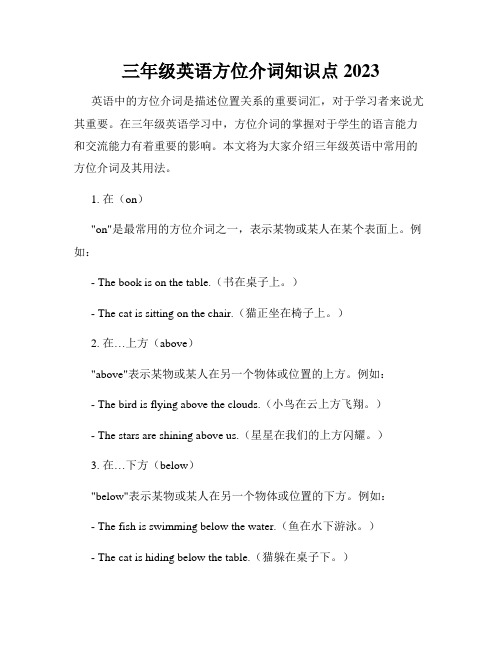
三年级英语方位介词知识点2023英语中的方位介词是描述位置关系的重要词汇,对于学习者来说尤其重要。
在三年级英语学习中,方位介词的掌握对于学生的语言能力和交流能力有着重要的影响。
本文将为大家介绍三年级英语中常用的方位介词及其用法。
1. 在(on)"on"是最常用的方位介词之一,表示某物或某人在某个表面上。
例如:- The book is on the table.(书在桌子上。
)- The cat is sitting on the chair.(猫正坐在椅子上。
)2. 在…上方(above)"above"表示某物或某人在另一个物体或位置的上方。
例如:- The bird is flying above the clouds.(小鸟在云上方飞翔。
)- The stars are shining above us.(星星在我们的上方闪耀。
)3. 在…下方(below)"below"表示某物或某人在另一个物体或位置的下方。
例如:- The fish is swimming below the water.(鱼在水下游泳。
)- The cat is hiding below the table.(猫躲在桌子下。
)4. 在…之间(between)"between"表示两个物体或位置之间的关系。
例如:- The bookshelf is between the window and the door.(书架在窗户和门之间。
)- The park is between the school and the hospital.(公园位于学校和医院之间。
)5. 在…旁边(beside)"beside"表示某物或某人在另一个物体或位置的旁边。
例如:- The tree is beside the river.(树在河边。
三年级英语方位介词知识点

三年级英语方位介词知识点方位介词是指用来描述事物位置关系的介词,在英语中常见的方位介词有in、on、at、under、over、behind、in front of、between等。
三年级学生需要学习掌握方位介词的用法,以便能准确描述事物的位置关系。
以下是三年级英语方位介词的知识点。
一、方位介词in的用法1. 表示在某个大区域内的位置,例如:in the classroom(在教室里)、in the park(在公园里)。
2. 表示在某个具体的物体内部,例如:in the box(在盒子里)、in the bag(在书包里)。
二、方位介词on的用法1. 表示在平面上的位置,例如:on the table(在桌子上)、on the floor(在地板上)。
2. 表示在某个具体的物体表面,例如:on the book(在书上)、on the wall(在墙上)。
三、方位介词at的用法1. 表示在某个地点,例如:at school(在学校)、at home(在家)。
2. 表示在某个位置上,例如:at the bus stop(在公交车站)、at the door(在门口)。
四、方位介词under的用法1. 表示在某物体下面,例如:under the tree(在树下)、under the bed(在床下)。
五、方位介词over的用法1. 表示在某物体上方,例如:over the bridge(在桥上)、over the head(在头上)。
六、方位介词behind的用法1. 表示在某物体的后面,例如:behind the chair(在椅子后面)、behind the car(在车后面)。
七、方位介词in front of的用法1. 表示在某物体的前面,例如:in front of the house(在房子前面)、in front of the mirror(在镜子前面)。
八、方位介词between的用法1. 表示在两个物体之间,例如:between the two trees(在两棵树之间)、between the two houses(在两座房子之间)。
介词知识点归纳总结
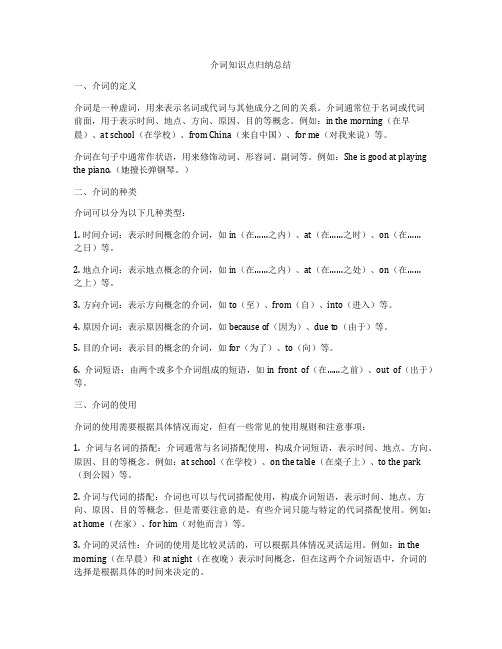
介词知识点归纳总结一、介词的定义介词是一种虚词,用来表示名词或代词与其他成分之间的关系。
介词通常位于名词或代词前面,用于表示时间、地点、方向、原因、目的等概念。
例如:in the morning(在早晨)、at school(在学校)、from China(来自中国)、for me(对我来说)等。
介词在句子中通常作状语,用来修饰动词、形容词、副词等。
例如:She is good at playing the piano.(她擅长弹钢琴。
)二、介词的种类介词可以分为以下几种类型:1. 时间介词:表示时间概念的介词,如in(在……之内)、at(在……之时)、on(在……之日)等。
2. 地点介词:表示地点概念的介词,如in(在……之内)、at(在……之处)、on(在……之上)等。
3. 方向介词:表示方向概念的介词,如to(至)、from(自)、into(进入)等。
4. 原因介词:表示原因概念的介词,如because of(因为)、due to(由于)等。
5. 目的介词:表示目的概念的介词,如for(为了)、to(向)等。
6. 介词短语:由两个或多个介词组成的短语,如in front of(在……之前)、out of(出于)等。
三、介词的使用介词的使用需要根据具体情况而定,但有一些常见的使用规则和注意事项:1. 介词与名词的搭配:介词通常与名词搭配使用,构成介词短语,表示时间、地点、方向、原因、目的等概念。
例如:at school(在学校)、on the table(在桌子上)、to the park (到公园)等。
2. 介词与代词的搭配:介词也可以与代词搭配使用,构成介词短语,表示时间、地点、方向、原因、目的等概念。
但是需要注意的是,有些介词只能与特定的代词搭配使用。
例如:at home(在家)、for him(对他而言)等。
3. 介词的灵活性:介词的使用是比较灵活的,可以根据具体情况灵活运用。
例如:in the morning(在早晨)和at night(在夜晚)表示时间概念,但在这两个介词短语中,介词的选择是根据具体的时间来决定的。
小学英语常用介词及用法
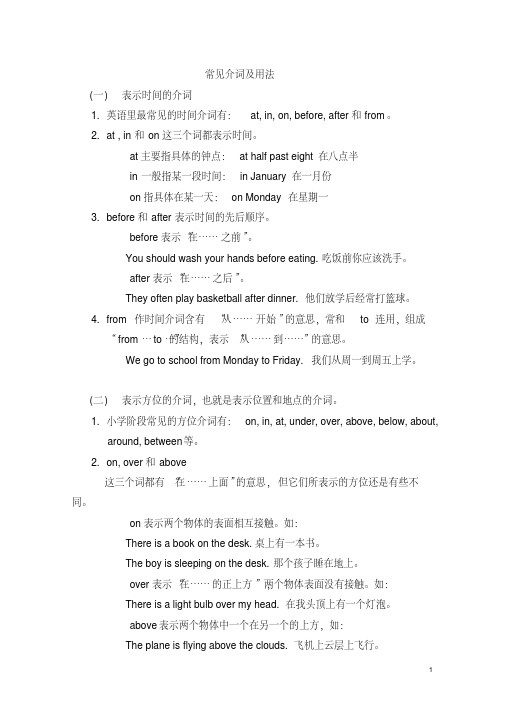
常见介词及用法(一)表示时间的介词1.英语里最常见的时间介词有:at, in, on, before, after和from。
2.at , in和on这三个词都表示时间。
at主要指具体的钟点:at half past eight 在八点半in一般指某一段时间:in January 在一月份on指具体在某一天:on Monday 在星期一3.before和after表示时间的先后顺序。
before表示“在……之前”。
You should wash your hands before eating. 吃饭前你应该洗手。
after表示“在……之后”。
They often play basketball after dinner. 他们放学后经常打篮球。
4.from作时间介词含有“从……开始”的意思,常和to连用,组成的结构,表示“从……到……”的意思。
“from…to…”We go to school from Monday to Friday. 我们从周一到周五上学。
(二)表示方位的介词,也就是表示位置和地点的介词。
1.小学阶段常见的方位介词有:on, in, at, under, over, above, below, about,around, between等。
2.on, over和above这三个词都有“在……上面”的意思,但它们所表示的方位还是有些不同。
on表示两个物体的表面相互接触。
如:There is a book on the desk. 桌上有一本书。
The boy is sleeping on the desk. 那个孩子睡在地上。
两个物体表面没有接触。
如:over表示“在……的正上方”,There is a light bulb over my head. 在我头顶上有一个灯泡。
above表示两个物体中一个在另一个的上方,如:The plane is flying above the clouds. 飞机上云层上飞行。
小学英语介词总结
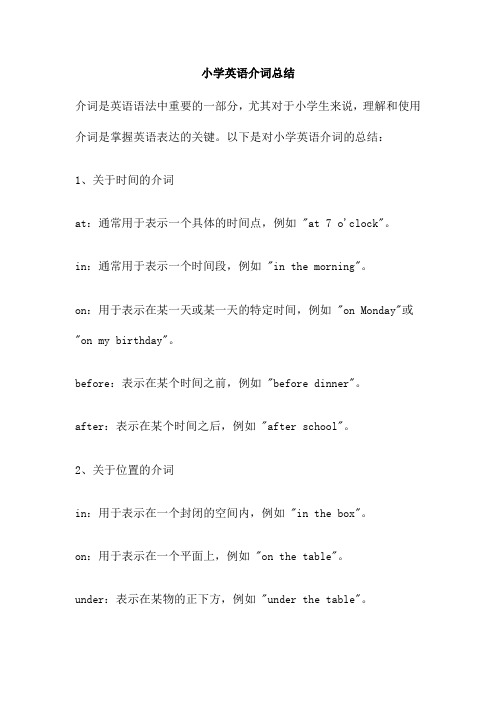
小学英语介词总结介词是英语语法中重要的一部分,尤其对于小学生来说,理解和使用介词是掌握英语表达的关键。
以下是对小学英语介词的总结:1、关于时间的介词at:通常用于表示一个具体的时间点,例如 "at 7 o'clock"。
in:通常用于表示一个时间段,例如 "in the morning"。
on:用于表示在某一天或某一天的特定时间,例如 "on Monday"或"on my birthday"。
before:表示在某个时间之前,例如 "before dinner"。
after:表示在某个时间之后,例如 "after school"。
2、关于位置的介词in:用于表示在一个封闭的空间内,例如 "in the box"。
on:用于表示在一个平面上,例如 "on the table"。
under:表示在某物的正下方,例如 "under the table"。
above:表示在某物的上方,但是不一定是正上方,例如 "above the table"。
beside:表示在某物的旁边,例如 "beside the book"。
3、关于方向的介词to:用于表示朝向某个方向或地点,例如 "go to school"。
from:用于表示从一个地方或位置到另一个地方或位置,例如 "come from school"。
towards:表示朝向某个方向或地点,但是不一定到达那里,例如"walk towards the park"。
4、关于原因的介词because:用于表示原因或理由,例如 "I am late because I missed the bus"。
英语介词知识点归纳
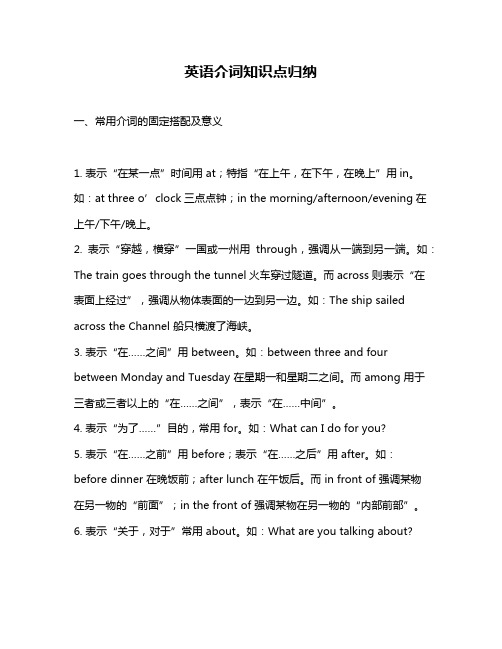
英语介词知识点归纳一、常用介词的固定搭配及意义1. 表示“在某一点”时间用 at;特指“在上午,在下午,在晚上”用in。
如:at three o’clock三点点钟;in the morning/afternoon/evening在上午/下午/晚上。
2. 表示“穿越,横穿”一国或一州用through,强调从一端到另一端。
如:The train goes through the tunnel火车穿过隧道。
而across则表示“在表面上经过”,强调从物体表面的一边到另一边。
如:The ship sailed across the Channel 船只横渡了海峡。
3. 表示“在……之间”用 between。
如:between three and four between Monday and Tuesday 在星期一和星期二之间。
而 among 用于三者或三者以上的“在……之间”,表示“在……中间”。
4. 表示“为了……”目的,常用 for。
如:What can I do for you?5. 表示“在……之前”用 before;表示“在……之后”用 after。
如:before dinner 在晚饭前;after lunch 在午饭后。
而 in front of 强调某物在另一物的“前面”;in the front of 强调某物在另一物的“内部前部”。
6. 表示“关于,对于”常用 about。
如:What are you talking about?7. 表示“除了……之外”用 except 或 besides。
如:All are here except Tom./ Besides you, I also know the answer.8. 表示“一个接一个,连续地”用 in turn。
如:They took the presents in turn.9. 表示“自……至……用from…to…” 如:from Monday to Friday 从星期一到星期五10. 表示“一方面的……另一方面……”常用 on one hand, on the other hand”。
小学的归纳与解析常见介词的用法和搭配规则
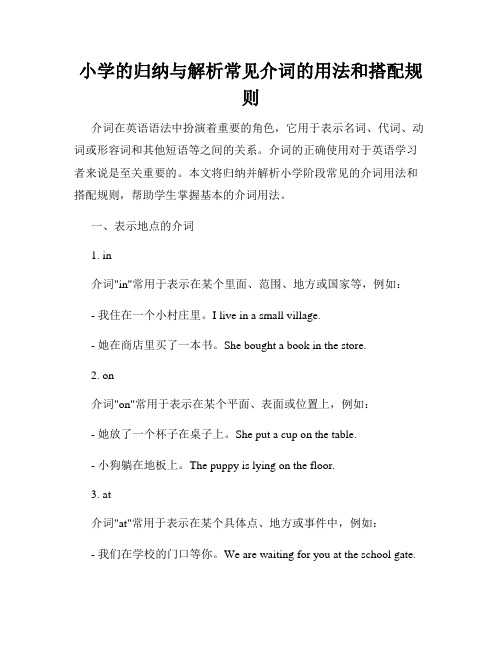
小学的归纳与解析常见介词的用法和搭配规则介词在英语语法中扮演着重要的角色,它用于表示名词、代词、动词或形容词和其他短语等之间的关系。
介词的正确使用对于英语学习者来说是至关重要的。
本文将归纳并解析小学阶段常见的介词用法和搭配规则,帮助学生掌握基本的介词用法。
一、表示地点的介词1. in介词"in"常用于表示在某个里面、范围、地方或国家等,例如:- 我住在一个小村庄里。
I live in a small village.- 她在商店里买了一本书。
She bought a book in the store.2. on介词"on"常用于表示在某个平面、表面或位置上,例如:- 她放了一个杯子在桌子上。
She put a cup on the table.- 小狗躺在地板上。
The puppy is lying on the floor.3. at介词"at"常用于表示在某个具体点、地方或事件中,例如:- 我们在学校的门口等你。
We are waiting for you at the school gate.- 她在图书馆参加了一个讲座。
She attended a lecture at the library.二、表示时间的介词1. in介词"in"常用于表示在某个时间段或月份中,例如:- 我在冬天喜欢滑雪。
I enjoy skiing in winter.- 我们将在十二月举办一次聚会。
We will have a party in December.2. on介词"on"常用于表示在某个具体日期或星期几,例如:- 他们将在星期五晚上去看电影。
They will go to the movies on Friday night.- 我的生日是在七月二十一日。
My birthday is on July 21st.3. at介词"at"常用于表示在某个具体时间点,例如:- 晚上九点钟我会在家里等你。
英语介词知识点归纳
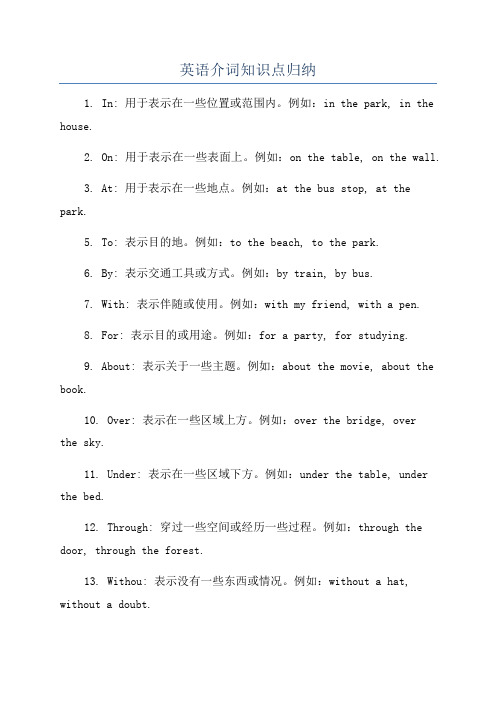
英语介词知识点归纳1. In: 用于表示在一些位置或范围内。
例如:in the park, in the house.2. On: 用于表示在一些表面上。
例如:on the table, on the wall.3. At: 用于表示在一些地点。
例如:at the bus stop, at the park.5. To: 表示目的地。
例如:to the beach, to the park.6. By: 表示交通工具或方式。
例如:by train, by bus.7. With: 表示伴随或使用。
例如:with my friend, with a pen.8. For: 表示目的或用途。
例如:for a party, for studying.9. About: 表示关于一些主题。
例如:about the movie, about the book.10. Over: 表示在一些区域上方。
例如:over the bridge, overthe sky.11. Under: 表示在一些区域下方。
例如:under the table, under the bed.12. Through: 穿过一些空间或经历一些过程。
例如:through the door, through the forest.13. Withou: 表示没有一些东西或情况。
例如:without a hat, without a doubt.14. Above: 表示在物之上。
例如:above the clouds, above the sign.15. Below: 表示在物之下。
例如:below the surface, below the line.。
- 1、下载文档前请自行甄别文档内容的完整性,平台不提供额外的编辑、内容补充、找答案等附加服务。
- 2、"仅部分预览"的文档,不可在线预览部分如存在完整性等问题,可反馈申请退款(可完整预览的文档不适用该条件!)。
- 3、如文档侵犯您的权益,请联系客服反馈,我们会尽快为您处理(人工客服工作时间:9:00-18:30)。
小学三年级英语介词知识点复习
介词是一种虚词,不能单独使用,必须在介词后面加上个名词或代词使用,作句子成份。
介词后面的名词(或相当于名词的其它词)叫做介词的宾语。
介词和介词宾语合称为介词短语。
介词短语在句中可作壮语、定语或表语。
介词如: in 在…里面on在…上面under在…下面等。
in the classroom 在教室in the tree 在树上in the hall 在大厅里on the road 在路上on the desk 在桌子上on the floor 在地板上under the table 在桌子底下under the bed 在床下under the chair 在椅子底下
网络搜集整理,仅供参考
1/ 1。
